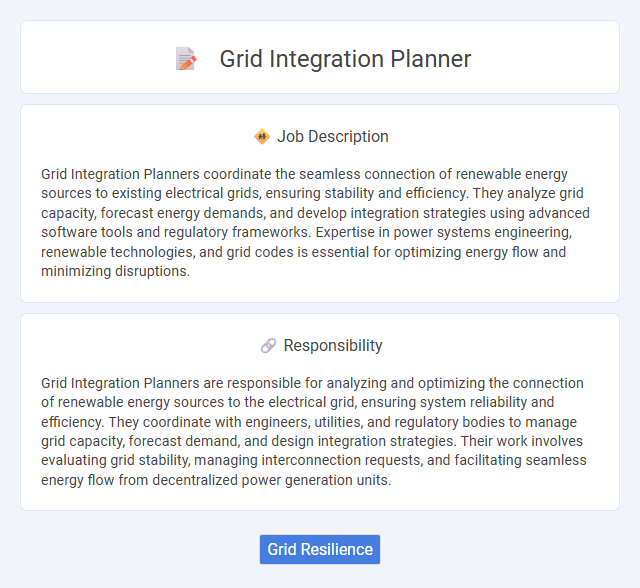
Grid Integration Planners coordinate the seamless connection of renewable energy sources to existing electrical grids, ensuring stability and efficiency. They analyze grid capacity, forecast energy demands, and develop integration strategies using advanced software tools and regulatory frameworks. Expertise in power systems engineering, renewable technologies, and grid codes is essential for optimizing energy flow and minimizing disruptions.
Individuals with a strong analytical mindset, an interest in renewable energy, and proficiency in data modeling are likely suitable for the Grid Integration Planner role. Candidates who thrive in collaborative environments and have the ability to navigate complex regulatory frameworks probably perform well. Those lacking technical expertise or discomfort with dynamic energy systems may find the position challenging.
Qualification
A Grid Integration Planner typically requires a bachelor's degree in electrical engineering, renewable energy, or a related field, with advanced knowledge of power systems and grid infrastructure. Proficiency in simulation software such as PSS(r)E, DIgSILENT PowerFactory, or MATLAB is essential for analyzing grid impact and integration feasibility. Strong project management skills and experience with regulatory standards and utility coordination enhance the candidate's effectiveness in ensuring reliable and efficient renewable energy integration.
Responsibility
Grid Integration Planners are responsible for analyzing and optimizing the connection of renewable energy sources to the electrical grid, ensuring system reliability and efficiency. They coordinate with engineers, utilities, and regulatory bodies to manage grid capacity, forecast demand, and design integration strategies. Their work involves evaluating grid stability, managing interconnection requests, and facilitating seamless energy flow from decentralized power generation units.
Benefit
A Grid Integration Planner likely improves the reliability and efficiency of power systems by optimizing the integration of renewable energy sources. This role probably enhances grid stability and helps reduce operational costs through strategic planning and advanced data analysis. Employers may experience increased flexibility in energy management and better compliance with regulatory standards as a result.
Challenge
Grid Integration Planners likely face the challenge of balancing the increasing complexity of integrating renewable energy sources with existing grid infrastructure. It is probable they must navigate regulatory constraints and technological uncertainties while ensuring grid reliability and stability. The role may demand strong analytical skills to anticipate and mitigate potential disruptions in energy distribution.
Career Advancement
Grid Integration Planners play a critical role in optimizing the connection of renewable energy sources to electrical grids, ensuring efficient energy distribution and system reliability. Advancing in this career typically involves gaining expertise in smart grid technologies, energy storage solutions, and regulatory compliance, leading to senior roles such as Grid Integration Manager or Energy Systems Director. Continuous professional development and certifications in power systems engineering and project management significantly enhance promotion prospects and salary growth within this dynamic field.
Key Terms
Grid Resilience
A Grid Integration Planner specializes in enhancing grid resilience by strategically coordinating the incorporation of renewable energy sources and energy storage systems into the existing power grid infrastructure. This role involves conducting rigorous impact assessments, modeling grid behavior under various stress scenarios, and developing solutions to mitigate risks related to outages and system failures. Expertise in power system dynamics, smart grid technologies, and regulatory compliance is essential to ensure a stable, reliable, and adaptable electricity supply.
 kuljobs.com
kuljobs.com